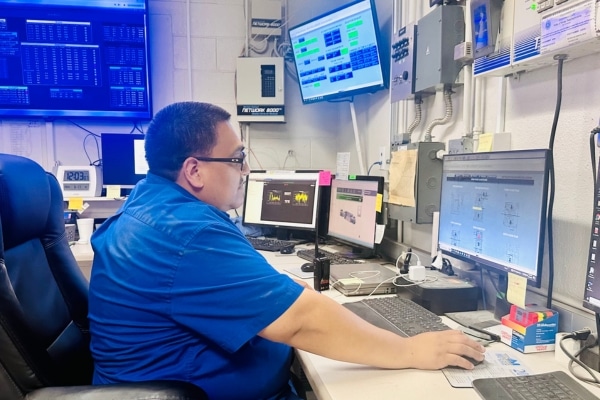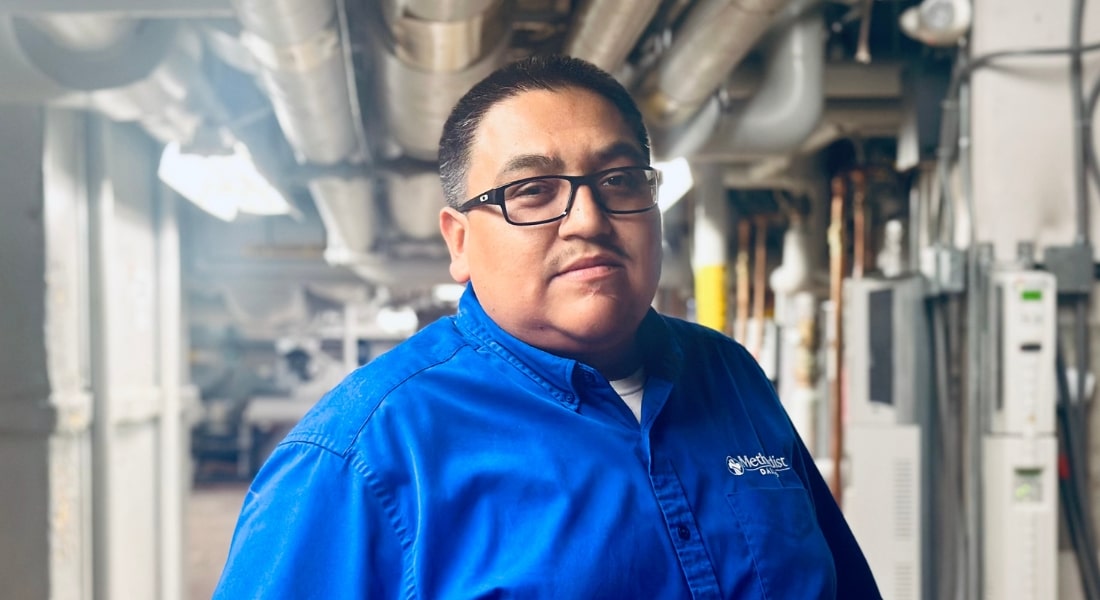Daniel Rodriguez feels a special bond with his co-workers at Methodist Dallas Medical Center, the same hospital where he had lifesaving surgery to remove a brain tumor in 2018.
“I thank everyone involved for saving my life,” says Daniel, who felt a greater purpose at work when his dream job opened up at the hospital years after his surgery. “And I thank Methodist for allowing me to now work alongside them.”
Just six years ago, the 39-year-old Dallas native wasn’t sure he’d be working anywhere for long when he learned a benign tumor was growing inside his skull, threatening his sight and his life.
“I really thought I was going to die,” he says.
That’s why Daniel is so grateful to the nurses and doctors on the medical staff he now works alongside as an HVAC engineer at Methodist Dallas.
“The staff was on point,” he says. “Whenever I needed something, they were there.”

TUMOR ON PITUITARY GLAND
Daniel first realized something was wrong when a series of bad headaches that felt unlike anything he’d ever experienced persisted for days.
“It was just constant pressure,” Daniel says.
Over-the-counter pain medications failed to provide any relief, so Daniel decided to seek help from Bala K. Giri, MD, neurosurgeon on the medical staff at Methodist Dallas.
That led to an MRI that revealed a benign brain tumor on Daniel’s pituitary gland, a pea-sized structure just behind the nose that produces and releases several hormones that carry out bodily functions like metabolism and growth.
Fortunately, Daniel’s tumor was not cancerous — most pituitary adenomas are benign — and it was nonfunctioning, which means it did not produce excess hormones.
Even so, such tumors are considered serious and potentially life-threatening. Vision loss was also a high possibility because it was larger than expected, about the size of a golf ball.
“It could have become incurable,” says Dr. Giri, who noted that it could spread to nearby cranial nerves that control eye movements.

MINIMALLY INVASIVE TECHNIQUE
Wasting no time, Dr. Giri prepared Daniel to undergo endoscopic resection, a minimally invasive procedure to remove the tumor using a flexible, tube-like instrument.
The endoscope goes through the nose to remove the tumor from the pituitary gland.
“Once I removed the tumor, I took some fat from the abdomen to put in the cavity that resulted from the tumor,” Dr. Giri says.
Daniel recovered in the hospital for a couple of days after the April 5, 2018, brain surgery, which lasted about five hours.
“I wasn’t out for very long,” Daniel says, “but I also didn’t want to rush back into work.”
Checkups followed about every six months and included physical exams, blood tests, and plenty of questions about recovery, side effects, and lingering symptoms.
“We’ll follow up with patients for at least five years to make sure there’s no recurrence,” Dr. Giri says.
Unlike their malignant counterparts, benign tumors don’t spread to other parts of the body, but they can still return after removal.
Approximately 16% of patients with a nonfunctioning or benign tumor will have a recurrence within 10 years, and 10% will require additional treatment.

LIFE COMES FULL CIRCLE
Healthy and pain-free again, Daniel went back to work. Following a brief recurrence four years ago, he returned to Methodist Dallas under happier circumstances.
In November 2022, he discovered an opportunity usually reserved for fairytale endings: There was a job opening at Methodist Dallas, and Daniel figured he was a perfect fit.
“I really wanted to work here,” he says. A few weeks later, Methodist called him, and his life would be changed once again.
“It was a Thursday afternoon, and I got a call from HR,” he says. “We started to talk over some things.”
An offer letter was subsequently extended, and Daniel started the following Monday.
For Daniel, the journey couldn’t have been more rewarding: to work at the same place where he had lifesaving surgery a few years earlier.
“I’m still here for a purpose,” he says.






